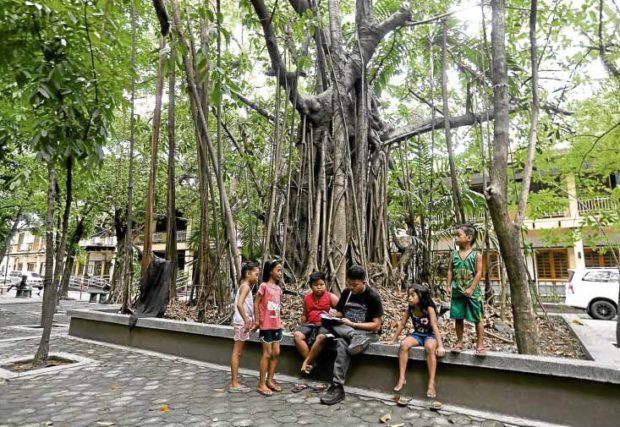
NURTURING HOPES A staff member of Childhope Philippines Foundation interviews children in front of a balete tree at Arroceros Forest Park, dubbed Manila’s “last lung.” —RICHARD A. REYES
MANILA, Philippines — A certain coolness welcomes visitors to the 2.1-hectare Arroceros Forest Park in Manila. While its environs swelter in the unforgiving heat, stench and noise, the park has a surprisingly refreshing feel.
The chug-chug of a rolling train, the siren of a fire truck and the honking of other motor vehicles seem to be filtered by the lush hardwood trees. The cacophony of Manila is muffled by the chirping of birds.
Arroceros Forest Park is so disconnected from the busy capital city that when a visitor finds herself standing beside one of the balete trees towering by the Pasig River, she is reminded of the kapre, nuno sa punso, dwende — all Philippine mythical creatures — said to dwell on or around big trees in remote provinces.
One side of the park shows a different perspective of the city. A visitor can sit on a concrete bench with a view of Quezon Bridge and the Masjid al-Dahab on the other side of the Pasig.
But refuge in this little oasis is not guaranteed. The guard on duty may turn visitors away because they must first present a letter to the schools superintendent to gain entry.
On weekdays when there is work at the Manila division office of the Department of Education (DepEd) — a building inside the park — a visitor must send a letter prior to entering. It is only on weekends that everyone is welcome to enter even without a formal request.
Still, Arroceros Forest Park is open to the public, the guard stressed.
Misconception
According to Chiqui Mabanta, president of Winner Foundation, which serves as guardian of the park, she receives calls every day asking if the park is open to the public.
She says there is no need to send a request to enter the park. Visitors can simply walk in.
There is a misconception that Manila’s “last lung” has been closed to the public following Mayor Joseph Estrada’s announcement in 2018 of his plan to build the University of Manila’s school gymnasium inside the park.
Winner Foundation opposed this move with a petition to save Arroceros Forest Park. The goal was 1,000 signatures on Change.org, but as of this writing, more than 113,000 had signed the petition.
“They’ve never been interested in this park, the [people at] City Hall. They’ve always just wanted to build something,” Mabanta told the Inquirer.
She recounted how, under the leadership of Mayor Lito Atienza, the park was threatened with demolition to give way for the DepEd’s Manila division office and a dormitory for women.
Atienza prevailed in the end and was able to build the division office, at the expense of 200 trees (or one-third of the tree population). The dense miniforest with a thick canopy was gone.
Nevertheless, the park has become a “bird haven.” Migratory birds like brown shrikes, barn swallows, common sandpipers and narcissus flycatchers have managed to build nests and find food in the small patch of greenery.
More than 150 species of plants also thrive in the park—most notably narra and molave trees classified as vulnerable and endangered species, respectively.
“It didn’t matter what the structure was, they just wanted to build, and by build they wanted to destroy this intact forest,” lamented Mabanta.
Parian de Arroceros
During the construction of the office building, archeologists unearthed china from the 17th century. According to Mabanta, the forest used to be the Parian de Arroceros — the settlement for Chinese merchants. Rice was sold in the area, hence the place was named after arroz, the Spanish word for rice.
The small forest was started 25 years ago by Winner Foundation. The city acquired the lot that was previously occupied by the then Department of Education, Culture and Sports.
“It started with debris. A lot of people think the park was always there, the forest was always there … There were a few old trees around in the perimeter of the [park], but [Winner Foundation] planted 3,000 trees,” said Mabanta.
The memorandum of agreement (MOA) between the City of Manila and Winner Foundation on the maintenance of Arroceros Forest Park never lapsed as the agreement was “an indefinite thing,” Mabanta said. It was the foundation that pointed out it would take 15 years to create a forest on the property along Antonio Villegas Street.
“The MOA says once the park is finished, Winner Foundation will turn over the park to the City of Manila and the city will continue to maintain it as a park,” Mabanta said.
Those who attempted to demolish the park arranged this 15-year deal, Mabanta said. But she noted that the MOA had never lapsed.
With the change of leadership in the city, Mabanta and the foundation are looking for a permanent MOA so the park would be safe in the future. Mayor-elect Francisco “Isko Moreno” Domagoso told Mabanta that he would preserve Arroceros Forest Park and not build structures in it.
“The park is safe for now — for the next three years at least,” Mabanta said.